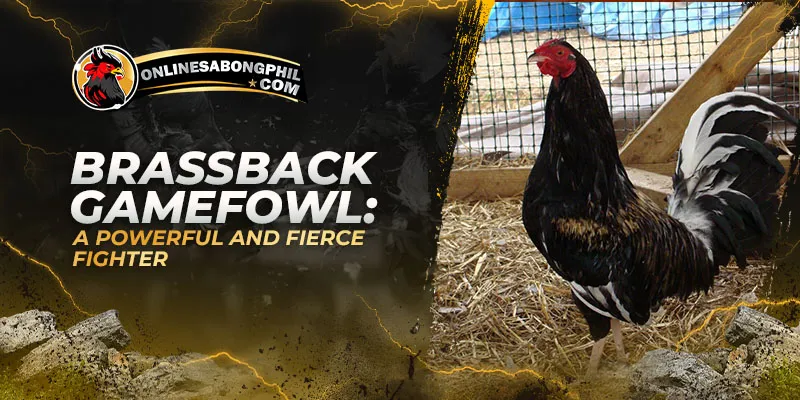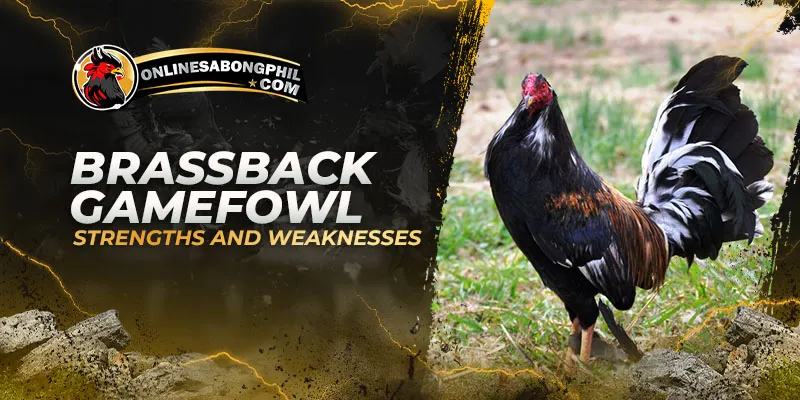The Brassback Gamefowl is a breed of chicken with uncertain origins, likely stemming from Old English Gamefowl and potentially some Oriental breeds. They are known for their distinctive brass-colored feathers, relatively large size, and aggressive, courageous temperament.
This gamefowl bloodline is one of the best sabong breeds; while aggressive, Brassbacks are also intelligent and fiercely territorial. They could be better for beginners and require experienced keepers who can handle their temperament.
Brassback Gamefowl History
Brassbacks are a specific color variation of Albany or Warhorse gamefowl lines. These lines are known for their exceptional fighting traits, which Brassbacks inherit and sometimes even surpass. Known for their explosive fighting style, Brassbacks combine speed, shuffling footwork, powerful strikes, and deep-cutting abilities. Their legendary gameness means they won’t back down even when seriously injured, often battling to the end. Despite their ferocity towards other roosters, Brassbacks are surprisingly docile with humans, making them easy to handle and train.
Brassback Gamefowl Characteristics
The Brassback Gamefowl, with its brassy feathers and robust build, symbolizes beauty and the darker side of animal breeding. Bred historically for cockfighting, it raises complex questions about aggression and ethics. Here are the characteristics of a bloodline:
Physical Traits
- Color: Distinctive brass-colored feathers on the back and breast, often combined with a black or red base color. This brass coloring can range from a lighter yellow-gold to a deep, coppery tone.
- Size: They are relatively large, with males reaching up to 10 pounds and females up to 8 pounds. This makes them a substantial breed compared to many other chickens.
- Build: They are short, compact, and muscular, with a broad chest and powerful legs. Their build is optimized for power and agility in the fighting pit.
- Head: It is small and round, with a short beak and wattles. A smaller head can be an advantage in fighting, as it presents a smaller target.
Behavioral Traits
- Combat style: Explosive and powerful. They are known for speed, shuffling footwork, stiff strikes, and profound cutting ability. Their combination of speed and power makes them formidable fighters.
- Gameness: They are legendary for their unwillingness to quit, even when facing severe injuries. They will often fight to the death. This gameness is a highly sought-after trait in cockfighting circles, but it emphasizes the cruelty of this bloodsport.
- Intelligence: Considered quite intelligent for a chicken breed, contributing to their fighting prowess. Their intelligence allows them to adapt and learn strategies within the fight.
Temperament
- Aggression: Extremely aggressive and territorial towards other roosters. This makes them unsuitable for most flocks. Their aggression is instinctual and deeply ingrained, posing management challenges.
- Human Interaction: Surprisingly docile and easy to handle for humans, despite their aggression towards other chickens. This contrast in temperament highlights the complex nature of the breed.
The Brassback Gamefowl reminds us of history’s fascination with bloodsports. While preservation of the breed may continue, it’s vital to promote humane treatment and emphasize that these animals deserve lives free from forced violence.
Fighting Style of Brassback Gamefowl
Brassback Gamefowl are known for their explosive and powerful fighting style. Here’s a breakdown of their fighting strategy:
- Speed and Agility: Brassbacks are surprisingly fast, allowing them to close the distance on opponents or dodge strikes quickly.
- Footwork: They are known for their shuffling footwork, constantly shifting their position to create attack angles and evade their opponent’s blows.
- Power Strikes: Despite their speed, Brassbacks pack a serious punch. Their compact, muscular build allows them to deliver hard, damaging blows.
- Cutting Ability: Brassbacks are often equipped with sharp spurs or blades (in cockfighting) that inflict deep, cutting wounds.
- Variety: While generally aggressive, some Brassback lines can be more strategic fighters. They might use their speed for hit-and-run tactics or outmaneuver their opponent.
Overall, the Brassback fighting style is a blend of pure aggression, speed, and the ability to inflict serious damage. This makes them formidable opponents in the fighting pit.
Brassback Gamefowl Strengths and Weaknesses
Here’s a breakdown of the Brassback Gamefowl’s strengths and weaknesses:
Strengths
- Gameness: Their legendary gameness is a major strength. They will continue fighting fiercely even when seriously injured.
- Power: Brassbacks are known for their hard-hitting power, which can quickly overwhelm and disable their opponents.
- Speed and Agility: They are surprisingly fast and agile, especially for their size, allowing them to deliver quick strikes and evade their opponent’s attacks.
- Intelligence: Their high intelligence level allows them to learn and adapt their fighting strategies.
Weaknesses
- Extreme Aggression: Their aggression, while a strength in some contexts, makes them very difficult to manage and unsuitable for coexisting with other roosters.
- Susceptibility to Injury: While playing, their aggressive style can sometimes make them prone to injury as they may prioritize offense over defense.
- Ethical Concerns: The breed’s history of use in cockfighting raises serious ethical concerns about animal cruelty, leading to the practice being illegal in many places.
- Not for Beginners: Their aggressive temperament and specific needs make them a very challenging breed for inexperienced chicken keepers.
Brassbacks are admired for their strength and agility, but their aggressive nature and vulnerability to injury, coupled with ethical concerns about their use in cockfighting, make them suitable only for experienced handlers.
Brassback Gamefowl Lifespan
The Brassback Gamefowl has a lifespan similar to other standard chicken breeds, averaging around 5-8 years. However, their lifespan can be influenced by factors like their quality of care (nutrition, housing, disease prevention), injuries sustained in fighting, predation risks, and individual genetic predispositions. With excellent care and peaceful life, a Brassback Gamefowl could potentially live up to 10 years or slightly longer.
Conclusion
Brassback Gamefowl is one of the top gamefowl bloodlines, known for its shiny brass-colored feathers and strong build. These birds are incredibly tough, powerful, and quick, showcasing some of the best traits in the gamefowl world. Although they are naturally aggressive and come with ethical concerns due to their history in cockfighting, with careful and responsible care, their positive qualities can be celebrated. By focusing on humane treatment, we can appreciate and maintain the Brassback Gamefowl’s important place in gamefowl history while promoting their well-being.
Visit us at Onlinesabongphil.com for more guides and tips!



